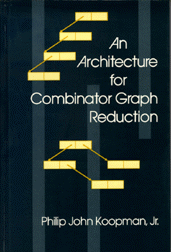
|
FreeComputerBooks.com
Links to Free Computer, Mathematics, Technical Books all over the World
|
|
- Title An Architecture for Combinator Graph Reduction (TIGRE)
- Authors Philip J. Koopman, Jr.
- Publisher: Academic Pr (October 1990)
- Hardcover 176 pages
- eBook Online, PDF files
- Language: English
- ISBN-10/ASIN 0124192408
- ISBN-13: 978-0124192409
- Share This:

|
The results of cache-simulation experiments with an abstract machine for reducing combinator graphs are presented. The abstract machine, called TIGRE, exhibits reduction rates that, for similar kinds of combinator graphs on similar kinds of hardware, compare favorably with previously reported techniques.
About the Authors- Philip J. Koopman, Jr. has done more than 125 design reviews of industry embedded systems, and teach embedded systems at Carnegie Mellon University. His other experiences include being a US Navy submarine officer in the Cold War, Navy computer system integration, embedded CPU IC design, research at United Technologies (elevators, cars, and many other embedded systems), and some startup companies.
- Graph Theory
- Combinatorics and Game Theory
- Discrete and Finite Mathematics
- Operations Research (OR), Linear Programming, Optimization, and Approximation
 Similar Books:
Similar Books:
-
 Graphs for Pattern Recognition: Systems of Linear Inequalities
Graphs for Pattern Recognition: Systems of Linear Inequalities
This book deals with mathematical constructions that are foundational in such an important area of Data Mining as Pattern Recognition. By using combinatorial and graph theoretic techniques, a closer look is taken at infeasible systems of linear inequalities.
-
 Spectral Geometry of Graphs (Pavel Kurasov)
Spectral Geometry of Graphs (Pavel Kurasov)
This open access book gives a systematic introduction into the Spectral Theory of differential operators on metric graphs. Main focus is on the fundamental relations between the spectrum and the geometry of the underlying graph.
-
 Games on Graphs (Nathalie Bertrand, et al.)
Games on Graphs (Nathalie Bertrand, et al.)
This book presents the state of the art on Games on Graphs, which is part of Game Theory. Games on graphs is the field concerned with games whose rules and evolution are represented by a graph.
-
 Graph Theory (Reinhard Diestel)
Graph Theory (Reinhard Diestel)
This book covers the core material of the subject with concise yet reliably complete proofs, while offering glimpses of more advanced methods in each field by one or two deeper results, again with proofs given in full detail.
-
 Hypergraph Computation (Qionghai Dai, et al.)
Hypergraph Computation (Qionghai Dai, et al.)
Comprehensive and systematic overview for Hypergraph computation. Rich blend of basic knowledge, theoretical analysis, algorithm introduction, and key applications. Describes hypergraph computation applications in computer vision, medical applications, etc.
-
 Deep Learning on Graphs (Yao Ma, et al)
Deep Learning on Graphs (Yao Ma, et al)
The book is a self-contained, comprehensive text on foundations and techniques of Graph Neural Networks with applications in NLP, data mining, vision and healthcare. Accessible to who want to use graph neural networks to advance their disciplines.
-
 Planar Maps, Random Walks and Circle Packing (Asaf Nachmias)
Planar Maps, Random Walks and Circle Packing (Asaf Nachmias)
This open access book focuses on the interplay between random walks on planar maps and Koebe’s circle packing theorem. Entirely self-contained. Many classical proofs have been simplified and streamlined. Contains numerous useful exercises.
-
 Digraphs: Theory, Algorithms and Applications (J. Bang-Jensen)
Digraphs: Theory, Algorithms and Applications (J. Bang-Jensen)
This book is an essential, comprehensive reference of Digraphs covering the theoretical aspects of the subject, focus on applications which include quantum mechanics, bioinformatics, embedded computing, and the travelling salesman problem.





